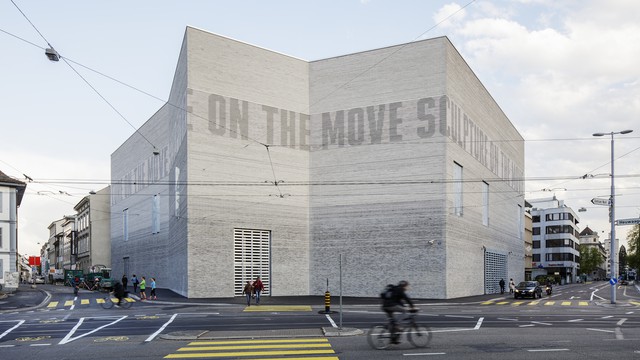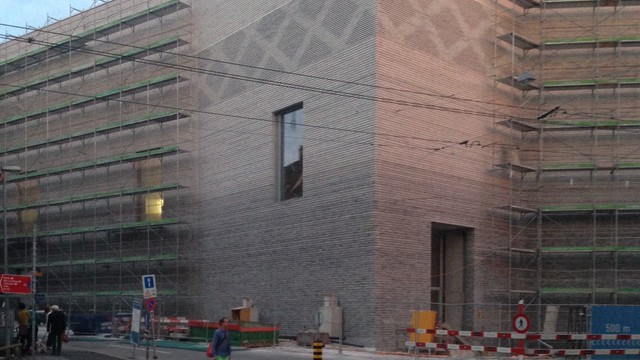LED Frieze of the New Building of the Kunstmuseum Basel 2016, Switzerland, Basel
Presumably the first shadow display in the world




The architects Christ & Gantenbein, together with the engineers and media designers at iart, developed an innovative media frieze for the new building of the Kunstmuseum Basel. By means of shadow and light, the frieze lets subtle animations appear on the seemingly archaic brick façade of the building. Brickwork and media elements of the circular, three metres high frieze thereby form a perfect symbiosis. Viewers see images made of light – or rather shadows – that are poetic and fleeting, yet at the same time appear as if set in stone. The result is a frieze which merges with the façade of the building, and even though it uses LEDs, does not have the appearance of a display, but enables a new form of media façade.
The architects Christ & Gantenbein, together with the engineers and media designers at iart, developed an innovative media frieze for the new building of the Kunstmuseum Basel. By means of shadow and light, the frieze lets subtle animations appear on the seemingly archaic brick façade of the building. Brickwork and media elements of the circular, three metres high frieze thereby form a perfect symbiosis. The stylistic element of the frieze – already used in ancient architecture for structuring and decorating buildings – has been successfully transferred into the digital age. The frieze area of the façade is characterised by horizontal joints that form a subtle relief. Daylight falling on the façade casts a shadow into the joints and thereby lets the frieze appear darker than the surrounding brickwork. This effect is used by a new shadow display as a creative means. White LEDs are mounted into the joints of the frieze, and while they are invisible from the street, they light the specially designed, concave fillets of the bricks from below and thus create an indirect, diffuse light. By partially illuminating the shadows in the joints, the frieze is therefore able to show animations of concrete images, abstract patterns and texts. During daytime, the brightness of the illuminated joints coincides with the brightness of the sunlight falling on the façade. Viewers see images made of light – or rather shadows – that are poetic and fleeting, yet at the same time appear as if set in stone. With fading daylight the medium adapts to the changed environmental conditions and increases in brightness. The illusion of a permeable facade is created, which seems to provide a view into the building from outside. The result is a frieze which merges with the façade of the building, and even though it uses LEDs, does not have the appearance of a display, but enables a new form of media façade.
http://www.hochbauamt.bs.ch/projekte/laufende-projekte/kunstmuseum-erweiterungsbau.html
Details
Building or project owner : Kunstmuseum Basel (CH)
Architecture : Christ & Gantenbein (CH)
Project artist/ concept/ design/ planning : Christ & Gantenbein, iart ag (CH)
Structural engineering : ZPF Ingenieure AG (CH)
Light design : iart ag (CH)
Lighting control software : iart ag (CH) with coolux pandoras box system
Project co-ordination : iart ag (CH)
Descriptions
Kind of light creation : The light is created by SMD LEDs (6000K), which are mounted on flat profiles and attached to the horizontal joints of the frieze. The LEDs illuminate the joints from below, creating an indirect and diffuse light through the reflection on the brick. Thus, every pixel has soft edges to the right and left and hard edges above and below.
Resolution and transmitting behaviour : The distance between each LED is 22 mm. Four LEDs in a row form one pixel. The frieze consists of 40 rows of pixels, with each row containing 1306 pixels, making its total resolution 1360 x 40 pixels. The LEDs reflect on the concave fillets of the bricks and thus create an indirect light within the joints of the frieze.
Pixel distance : 88 millimetres (hor.) / 80 millimetres (vert.)
Luminace : The luminance varies depending on the natural daylight situation. Sensors installed on the roof of the building measure the light falling on each segment of the façade. The luminance of the LEDs is adjusted accordingly. During daytime (negative display) it matches the luminance of the daylight. At night (positive display) the LEDs shine more brightly.
Urban situation : The new building of the Kunstmuseum Basel is situated in the center of the city on a street crossing with five different visual axes.
Description of showreel : Very subtle text elements (in a custom-developed font, e.g. titles of current or upcoming exhibitions), ornaments and images that change very slowly, at times almost imperceptibly. During daytime, the animations look as if set in stone. Although using LEDs, the frieze does not have the appearance of a light-emitting display.